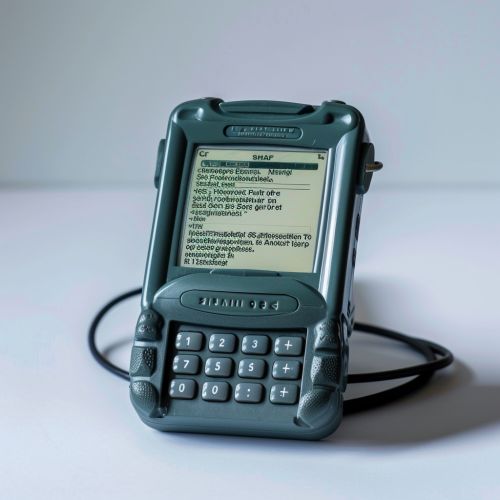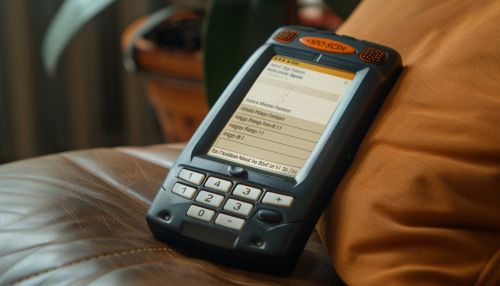Alphanumeric Pager
Introduction
An alphanumeric pager is a type of pager that allows the transmission of both text and numeric messages. Unlike traditional numeric pagers, which can only display numbers, alphanumeric pagers can display a combination of letters and numbers, enabling more detailed and informative messages. These devices were widely used before the advent of modern smartphones and continue to be utilized in specific industries due to their reliability and simplicity.
History
The development of alphanumeric pagers can be traced back to the 1980s when advancements in telecommunications technology allowed for more sophisticated messaging capabilities. Early pagers were limited to numeric messages, primarily used for sending phone numbers. The introduction of alphanumeric pagers marked a significant evolution, enabling users to receive text messages, which could include detailed instructions or information.
Technology
Alphanumeric pagers operate using radio frequency (RF) signals to receive messages. These messages are transmitted by a network of base stations that cover a specific geographic area. The pagers are equipped with a receiver that decodes the RF signals into readable text messages. The technology behind alphanumeric pagers includes several key components:
Transmission Protocols
Alphanumeric pagers use specific protocols for message transmission, such as POCSAG (Post Office Code Standardization Advisory Group) and FLEX. POCSAG is an older protocol that supports both numeric and alphanumeric messages, while FLEX is a more advanced protocol that offers higher data rates and better error correction.
Frequency Bands
Pagers typically operate in the VHF (Very High Frequency) and UHF (Ultra High Frequency) bands. These frequency bands are chosen for their ability to provide wide coverage areas and penetrate buildings, making them ideal for urban environments.
Message Encoding
Messages sent to alphanumeric pagers are encoded using specific character sets, such as ASCII (American Standard Code for Information Interchange). This encoding allows for the representation of letters, numbers, and special characters, enabling the transmission of complex messages.
Applications
Alphanumeric pagers have been used in various industries due to their reliability and simplicity. Some of the key applications include:
Healthcare
In the healthcare industry, alphanumeric pagers are used by doctors, nurses, and other medical staff to receive critical information quickly. The ability to receive detailed text messages allows healthcare professionals to respond promptly to emergencies and coordinate patient care effectively.
Emergency Services
Emergency services, including firefighters, police, and paramedics, rely on alphanumeric pagers for dispatching and communication. The robustness of pager networks ensures that messages are received even in areas with poor cellular coverage, making them essential for emergency response.
Business and Industry
Many businesses use alphanumeric pagers for internal communication and coordination. Industries such as manufacturing, hospitality, and transportation benefit from the instant and reliable messaging capabilities of pagers, which help streamline operations and improve efficiency.


Advantages
Alphanumeric pagers offer several advantages over other communication devices:
Reliability
Pagers are known for their reliability, especially in environments where cellular networks may be congested or unavailable. The dedicated pager networks ensure that messages are delivered promptly and accurately.
Battery Life
Alphanumeric pagers typically have long battery life compared to smartphones. This makes them ideal for use in situations where charging opportunities are limited, such as in remote locations or during extended shifts.
Simplicity
The simplicity of alphanumeric pagers makes them easy to use and maintain. There are no complex interfaces or applications to manage, which reduces the likelihood of user error and technical issues.
Limitations
Despite their advantages, alphanumeric pagers have some limitations:
Limited Functionality
Compared to modern smartphones, alphanumeric pagers have limited functionality. They are primarily designed for receiving messages and do not support voice calls, internet access, or multimedia capabilities.
Coverage Area
The coverage area of pager networks is limited to specific regions. While they provide excellent coverage within these areas, users may experience gaps in service when traveling outside the network's range.
Message Length
The length of messages that can be sent to alphanumeric pagers is typically limited. This constraint requires messages to be concise, which may not always be suitable for conveying complex information.
Future of Alphanumeric Pagers
While the widespread adoption of smartphones has reduced the prevalence of alphanumeric pagers, they continue to have a niche market. The future of alphanumeric pagers lies in their continued use in specific industries where their reliability and simplicity are valued. Additionally, advancements in pager technology, such as integration with modern communication systems, may extend their relevance.
See Also
- Telecommunications
- Radio Frequency
- ASCII
- POCSAG
- FLEX
- Healthcare Communication
- Emergency Services
- VHF
- UHF
